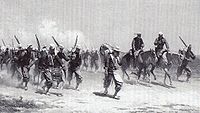Belgian Volunteer Corps
The Belgian Volunteer Corps ( Dutch : Vrijwilligerskorps ; French: Légion belge ) was a military unit, which from 1865 to 1867 - during the French intervention in Mexico - on the side of Emperor Maximilian I against the republican troops of the President of Mexico Benito Juarez fought. Since Empress Charlotte ( Charlotte of Belgium ), the wife of Emperor Maximilian, was the daughter of the Belgian King Leopold I , sympathies for Maximilian's rule in Mexico also arose in Belgium . However, there was no official support from the Belgian government for Maximilian's empire . Belgium wanted to remain officially neutral on the Mexican question.
Lineup
The volunteer corps was set up by Lieutenant General Chapélie, the commander of the Royal Military School , in September / October 1864 around Oudenaarde . Mainly out of a thirst for adventure, many soldiers , cadets and officers of the Belgian army volunteered . Finally, a regiment ("Kaiserin Charlotte") with 1,558 soldiers, NCOs and officers could be formed, which should act as bodyguard for Empress Charlotte. The regiment consisted of two battalions of infantry (the 1st Battalion "Impératrice" with 6 companies of grenadiers and the 2nd Battalion "Roi des Belges" with 6 companies of voltigeurs ) and was commanded by Lieutenant Colonel Alfred van der Smissen . The corps was armed and equipped with French help and shipped from St. Nazaire (France) to Vera Cruz (Mexico) between October 1864 and January 1865.
Use in Mexico
Battle of Tacámbaro
Soon after the one-month crossing, the Belgian volunteer corps intervened in the fighting against the republican troops and suffered a heavy defeat (around 300 Belgian legionnaires) on April 11, 1865 in the battle of Tacámbaro (about 110 km west of Mexico City ) are killed or have to surrender after heavy fighting against the outnumbered troops of the Juaristas). Major Tydgadt, in command of the Voltigeurb Battalion, and his adjutant Baron Chazal (son of the Belgian Minister of War) were killed in action.
More major fighting
- July 16, 1865: Battle of Loma (conquest of the city by the Belgians)
- April 16, 1866: Battle of Marin (victory of the Belgians over the Juaristas)
- June 18, 1866: Battle of Charco Redondo (the Belgians claim the battlefield)
- September 25, 1866: Beginning of the unsuccessful expedition to Ixmiquilpan
Return and dissolution
On December 24, 1866, Empress Charlotte thanked the legionnaires personally for their commitment. The remaining soldiers were given the opportunity to join the Imperial Mexican Army . In view of the hopeless situation of Emperor Maximilian, however, only a few made use of it.
The rest of the corps was embarked for Europe on January 20, 1867, where the surviving 754 legionnaires arrived in Antwerp on March 9, 1867 and the unit was disbanded.
Commemoration
In Oudenaarde (De treurende vrouw - La femme éplorée) and in Beverloo , memorials commemorate the Belgian volunteer corps.
Trivia
There are rumors that the French Marshal Maxime Weygand was the son of Empress Charlotte and Lieutenant Colonel Van der Smissen.
literature
- Albert Duchesne: L'expédition des volontaires belges au Mexique, 1864–1867. Musée royal de l'Armée et d'histoire militaire, Brussels, 1968
Web links
- Belgian Vrijwilligerskorps in Mexico 1864–1867. Retrieved December 29, 2009 (Dutch).
- The Mexican Adventure. Retrieved December 29, 2009 .
Individual evidence
- ^ Ernst Schmit Von Tavera: History of the government of the emperor Maximilian I .. BiblioBazaar, 2008, ISBN 978-0559698118 , p. 381 ( Google book online ).
